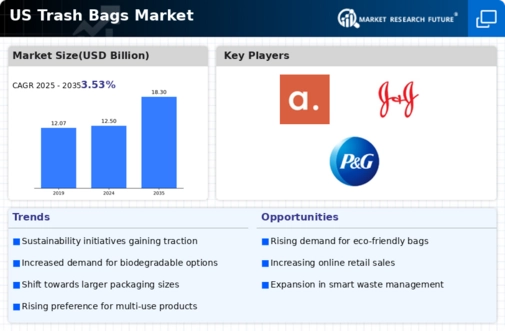Rising Environmental Awareness
The increasing awareness regarding environmental issues is a pivotal driver in the trash bags market. Consumers are becoming more conscious of their ecological footprint, leading to a demand for eco-friendly products. This trend is reflected in the market, where biodegradable and compostable trash bags are gaining traction. In 2025, it is estimated that eco-friendly trash bags could account for approximately 30% of the total market share. The trash bags market is responding by innovating and developing products that align with sustainable practices, thus appealing to environmentally conscious consumers. Companies that prioritize sustainability in their product offerings are likely to capture a larger segment of the market, as consumers increasingly prefer brands that demonstrate a commitment to environmental stewardship.
Shifts in Consumer Preferences
Shifts in consumer preferences are a driving force in the trash bags market. As lifestyles evolve, consumers are increasingly seeking convenience and functionality in their waste disposal solutions. This trend is evident in the rising popularity of specialty trash bags, such as those designed for specific purposes like yard waste or pet waste. The trash bags market is responding by diversifying product offerings to meet these changing preferences. Industry expert's indicates that specialty bags could see a growth rate of 10% annually, reflecting the need for tailored solutions. Companies that can effectively identify and cater to these preferences are likely to thrive in a competitive landscape.
Regulatory Changes and Compliance
Regulatory changes regarding waste management and environmental protection are shaping the trash bags market. Governments at various levels are implementing stricter regulations on waste disposal and recycling, which directly impacts the types of trash bags that can be used. For instance, certain states have enacted laws banning single-use plastic bags, prompting manufacturers to innovate and produce compliant alternatives. The trash bags market must navigate these regulatory landscapes, which may lead to increased production costs but also opens opportunities for growth in the biodegradable and reusable segments. Compliance with these regulations is essential for companies aiming to maintain market share and avoid penalties.
Urbanization and Population Growth
Urbanization and population growth are significant factors influencing the trash bags market. As more individuals migrate to urban areas, the demand for waste management solutions, including trash bags, escalates. The U.S. Census Bureau projects that urban populations will continue to rise, potentially increasing the demand for trash bags by 15% over the next five years. This growth in urban areas often correlates with higher waste generation, necessitating efficient waste disposal methods. Consequently, the trash bags market must adapt to this increasing demand by offering a variety of products that cater to diverse urban lifestyles, including larger capacity bags and specialized options for different waste types.
Technological Advancements in Manufacturing
Technological advancements in manufacturing processes are transforming the trash bags market. Innovations such as improved polymer technology and automated production lines enhance the efficiency and quality of trash bag production. These advancements allow manufacturers to produce stronger, more durable bags while potentially reducing costs. In 2025, it is anticipated that the integration of smart manufacturing technologies could lead to a 20% increase in production efficiency within the trash bags market. As companies adopt these technologies, they can respond more effectively to consumer demands for high-quality products, thereby gaining a competitive edge in the market.














Leave a Comment